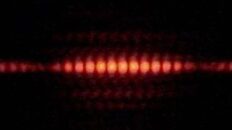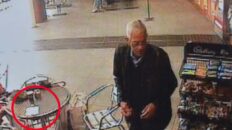The first sound recording is often credited to Thomas Edison, but in 1857, a typographer named Édouard-Léon Scott de Martinville actually beat him by inventing the phonautograph, a device designed to capture sound waves on paper. It was never meant to be heard, but more than 150 years later, researchers were able to reproduce the sound and bring it back to life. It’s an amazing story – and it happened almost on accident.
TRANSCRIPT:
Maybe tell the story of when Edison presented the first gramophone and how revolutionary that was. I made the point one time that before the gramophone and radio, it was customary for someone in every household to know how to play music, because that was the only way many people could experience it at home.
Ironically, becoming musically literate is less important than it used to be, but music is ubiquitous in our lives now, and the ability to record it is more democratized than ever.
The 60s were a time of unrest in the U.S. and around the world. There were wars, cultural upheavals, and huge advances in technology. Also, everyone rode horses.
Because I’m talking about the 1860s.
That’s right, the 1860s, Dickens was blowing up the charts in the UK, Louie Pasteur invented germophobia, and the Gatling gun made war 1000 times worse. And we did have war here in the Americas, of course I’m talking about the Second Franco-Mexican War where Mexican troops defeated French forces at the Battle of Puebla on May 5, 1862.
Cinco de Mayo.
Oh, and the US was kinda two countries for a minute there.
But technologically, Elisha Graves Otis patented elevator safety brakes, making it possible to build taller buildings, railroads and trains were gaining steam and just a few years after, the typewriter would revolutionize the way we record and share information.
But there was a mostly forgotten invention that made all this possible, and it was invented by accident.
But the invention of the typewriter was the end of a long process that began in the 1820s with an invention called the typographer
William Austin Burt invented the typographer in 1829. And he was basically trying to invent a miniature printing press. Something that was smaller and faster than setting type.
It kind of looked like a pinball machine. Paper was rolled into a cylinder that could be rotated with a dial and a swinging lever would make impressions of upper and lower-case letters.
It did the job, but it was still very slow and time consuming, and its usefulness was limited so it just never took off.
At that point, the printing press had been around for over 400 years. And it did a good job of reproducing things, but if you wanted to dictate what someone said, basically translate speech to text, it was still all paper and pen.
The typographer was an attempt to solve that problem but it was still way too slow. But it did give someone an idea.
Édouard-Léon Scott de Martinville was a typographer and stenographer in France, and he had a particular interest in this problem, obviously, this was what he did for a living, so like every infomercial, he said to himself, “There’s got to be a better way!”
I mean think of the cramps the guy probably got all the time.
So one day he took a job transcribing a book on human anatomy called Traité de Physiologie by F.A. Longet. And when he got to the part about how the ear works, it got him thinking.
If sounds are just vibrations in the air and the eardrum captures those vibrations and transmits them through a series of bones… Could it be possible to do the same thing but have it vibrate a stylus?
And then just like the typographer machine had paper on a cylinder that you could turn, maybe you could do the same thing, put it up against this vibrating stylus, and record those vibrations on paper?
So in 1853, he started working on what he called the problem of speech writing, writing:
“Will one be able to preserve for the future generation some features of the diction of one of those eminent actors, those grand artists who die without leaving behind them the faintest trace of their genius?”
Four years later, he released his artificial ear dictation machine to the world, which he called the phonautograph.
He would cover a plate of glass – and later it could become a cylinder with a very, very thin layer of lampblack. Soot, basically. Above this, he would fix an acoustic trumpet with a membrane the diameter of a five-franc coin at its small end, to emulate an eardrum.
At the center, he affixed a fine and rigid stylus and adjusted the trumpet so the stylus would barely graze the lampblack.
Then, he would rotate the cylinder and speak in the vicinity of the trumpet’s opening. This would cause the membrane to vibrate and the stylus to trace figures. He called the process phonautography.
And it worked! He had, for the first time, created a visual representation of the human voice.
This work got the attention of of the – Jesus help me – Société d’encouragement pour l’industrie nationale (SEIN)
SEIN was basically a group of experts that evaluated new tech and its potential contributions to French industry.
In 1859, Scott partnered with Rudolph Koenig, a maker of scientific instruments. But their interests eventually diverged. Koenig was interested in the more scientific implications of transmitting sound waves, Scott was more focused on the voice dictation thing.
Scott ran out of funds to continue his research. But Koenig continued to manufacture and improve the phonautograph before it became obsolete.
Which it eventually did. Thomas Edison would famously create something similar that he called the phonograph, but his allowed you to play the sound back. And that was game over.
Look, I know the anti-Edison comments are already flying, yes, we all hate Edison, he took credit for other people’s work, he was a ruthless businessman and self-promoter, but, there’s no evidence he took from Scott, or even knew about the phonautogram.
In fact, he was working on the telephone when he had a parallel idea. As one of his assistants explained years later:
“We were sitting around. We’d been working on the telephone — yelling into diaphragms. And Edison turned to me, and he said, ‘If we put a needle or a pin on this diaphragm, it’ll vibrate, and if we pull a strip of wax paper underneath it, it should leave marks. And then if we pull that piece of paper back, we should hear the talking.’”
Another reason to believe that he didn’t know about the phonautograph is that Edison thought that his recordings would come out as a series of dots – he imagined the human voice was a series of impulses, so he expected dots, but instead he got squiggles. And this surprised him.
So obviously he wasn’t familiar with the phonautograph because he had no idea that there would be squiggles.
Also, there will be squiggles is my favorite Daniel Day Lewis film.
Edison’s machine recorded on tinfoil and in 1877, he recorded himself reciting Mary Had A Little Lamb.
This was the oldest recording of the human voice in human history… For a hundred and thirty one years.
Okay, so here’s what happened, while Scott’s invention didn’t set the world on fire, some of his phonautograph recordings did make their way to the French National Academy of Sciences, where they were kept in storage, kind-of an interesting side note in the history of sound recordings.
But in 2008, a group of researchers called First Sounds tracked down Scott’s recordings.
Led by David Giovannoni, First Sounds set out to find and archive the oldest sound recordings, and they were able to take a few of Scott’s phonautographs from 1860 and convert them into audible sound files.
And one of the first things they noticed was that there a hum underneath everything, which they couldn’t figure out what it was at first, they thought maybe it was a defect in the device, but it wasn’t… it was a tuning fork.
Why did he mess up his recording with a tuning fork? Well, since he was hand-cranking the cylinder for recording and he knew he couldn’t possibly keep it rotating at a perfectly steady speed, he recorded a tuning fork along with him to serve as a kind of time code.
Because the tuning fork would operate at a constant frequency, he knew that he could use that to realign the recording. I mean that’s kind-of genius.
And that’s exactly what they were able to do. They cleaned up the phonautograph in an audio editing program and manually adjusted the sound waves using the tuning fork sound to smooth out speed fluctuations.
The sound they were able to pull from it, which they think is Scott himself, singing Au Clair de la Lune, is now considered to be the oldest recording ever made of the human voice. It was recorded on April 9, 1860. And it sounds like this:
It’s rough – and there are no words, but it’s definitely a song.
As Patrick Feaster told Lapham’s Quarterly in 2017:
“The real moment when I knew that this was going to work was when I finally got to the second different note in ‘Au Clair de la Lune.’ That first series of notes could just be coincidence, but when it goes up where it’s supposed to, you know it’s worked.”
By the way, if you don’t know Au Clair de la Lune, it’s a French folk song that goes like this:
There were other recordings from that same year that they were able to make audio out of and the recording quality got progressively better. There was another rendition of Au Clair a la Lune from April 20th 1860:
http://www.firstsounds.org/sounds/Scott-Feaster-No-44.mp3
And an ascending scale he recorded on May 17 of 1860:
http://www.firstsounds.org/sounds/1860-Vocal-Scale-05-09.mp3
So today, Édouard-Léon Scott de Martinville is considered the first person to record the human voice. It just took technology 131 years to decipher it.
Though it should be said that a French inventor named Charles Cros saw the potential of the phonautograph and proposed using the same idea to record and playback audio. He filed this idea with the French Academy of sciences in April 1877, just a few weeks before Edison unveiled the phonograph.
In his filing describing how the machine would work, Cros wrote:
“A lightweight index is fixed to the center of figure of a vibrating membrane, it ends with a tip […] based on a blackened surface flame. This surface is integral with a disc driven by a double movement of rotation and linear progression. The system is reversible: when the tip makes ironing in the furrow membrane restores the original acoustic signal.“
Cros called this the paléophone and while he did file it before Edison, his machine required photographic and chemical engraving processes, Edison’s didn’t. Also, Cros didn’t have the resources to make a prototype of his idea, but Edison had plenty of resources.
Neither knew of the other’s ideas, by the way.
So, yeah Cros never built his device, but he did have a lot of literary friends who vouched for him in the press and he’s long been celebrated in France as the guy who beat Edison by a few weeks.
Well, now France has a guy who beat him by 17 years.
In fairness to Edison though, all his self-promotion paid off because it was only after his device that sound recording really took off.
In fact, Edison’s tin foil recordings only lasted a few years before Alexander Graham Bell, his cousin Chichester A. Bell, and Charles Sumner Tainter set out to improve the phonograph in 1880.
They decided to use wax instead of tin foil and a floating stylus instead of a rigid needle. They were awarded a patent for their machine on May 4, 1886, and they called it the graphophone.
Emil Berliner was granted a patent in 1887 for his gramophone that featured flat wax discs, which he chose to avoid the patents on cylinders and because they were cheaper to make.
But Valdemar Poulsen did in 1898 and called it the telegraphone.
Long-play vinyl records came on the scene in 1948.
In 1949, we see the start of magnetic tape recording. In 1964, there was the first cassette player, followed two years later by the first 8-track.
The first reel-to-reel decks showed up in 1972, and commercial sales of CDs began in 1982.
The digital audio tape was invented in 1990. MP3 compression began in 1995.
And audio technology is still progressing. One example is the i3DS developed by Noveto Systems.
It uses a 3D sensing module from a speaker that locates and tracks the positions of a listener’s ears.
It then sends audio using ultrasonic waves that create sound pockets by the listener’s ears. The audio can be heard in stereo or 360 degrees around the listener — all without headphones.
And then there’s the visual microphone. It’s an algorithm developed by researchers at MIT, Microsoft, and Adobe.
This uses a camera to record the minute vibrations of objects in a room – anything from a glass of water to a plant to a bag of Cheetos.
The researchers then reconstruct the audio from those vibrations using an algorithm, basically turning the object into a visual microphone.
For example, they recovered speech from the vibrations on a potato-chip bag filmed 4.5 meters away through soundproof glass.
That’s bonkers. And makes me a little paranoid.
I mean, does this mean that anybody can just point a camera through my window at a plant in the room and hear everything I’m saying? Technically, yes. Technically yikes.
But I find a nice symmetry to this, it’s like it’s all come full circle. The earliest recording technology was just visual representations of sound waves, and the newest technology is just recording sound waves visually.
I wonder what Eduard would think if he knew that someday far into the future people would hear these rubbings he made? That certainly wasn’t his initial goal, he was hoping for a way to “read” them.
I’m sure he couldn’t have imagined that the scribbles could be digitally imaged and fed into a computer that could translate them into sound through speakers – none of those things were even conceivable when he did this.
Either way, it speaks to how ahead of his time he was, and how clever people really were back then. And I think that’s pretty cool.




Add comment